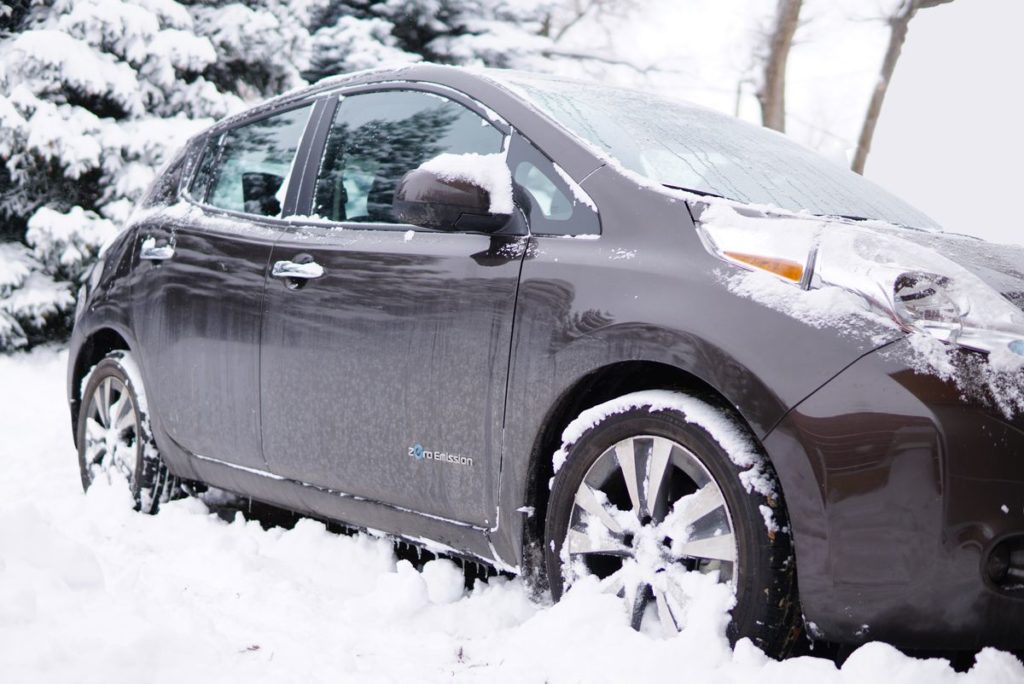Electric Car vs. Winter
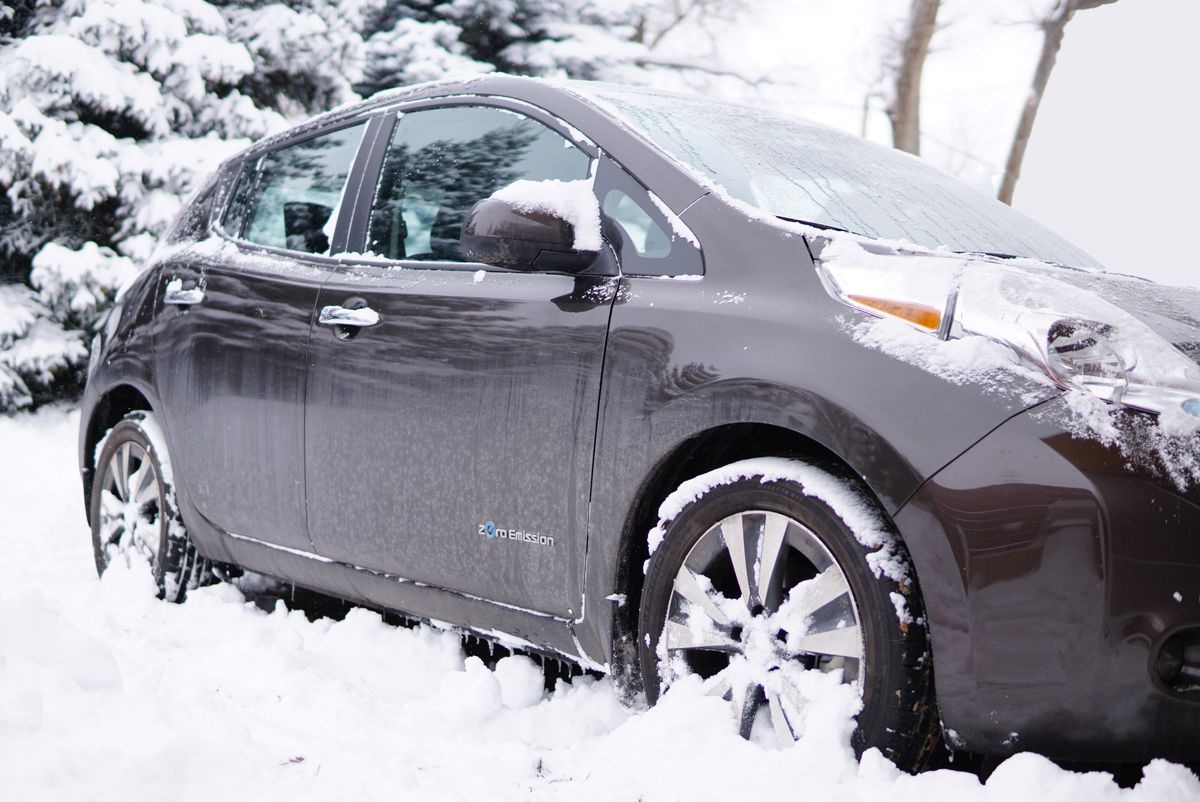
Just a few days ago, I got a surprise in the mail. It was a very expensive registration renewal bill* from Boulder County, reminding me that my brand-new 2016 Nissan Leaf was already a whole year old.
The car has now been through the full cycle of Colorado's interesting driving conditions including blazing sunshine, blowing blizzards, rough roads and high mountain passes. More importantly, it has carried large loads of heavy people and one hatchback-busting load of cargo after another as I used it for endless construction projects as well as shuttling around visitors and even a few paying passengers as part of a related Uber-driving experiment.
Since I bought the car primarily so I could tell you about the experience**, this one year anniversary presents the perfect opportunity.
Electric cars have been getting better and cheaper very quickly. Even a year ago, they were competitive with gas cars (especially after applying the various tax credits available here in the US). And as of late 2017, Nissan has just announced a thoroughly updated 2018 Leaf with longer range, new styling, and even semi-autonomous highway cruising, at the same list price.
Halfway through my time writing this article, General Motors announced that it is totally giving up the gasoline engine and switching to a 100% electric fleet in the foreseeable future.
Changes like these will get even more people asking questions, and it will surely trigger even bigger discounts on the 2017 and earlier models of electric cars. In certain areas, you can get a brand-new 2017 Leaf for well under $14,000 and a 2013 from Craigslist for under $8k.
So let's get into the report. All year, people have been asking what the electric car experience has been like.
- Is the car reliable? Any unexpected hiccups?
- How has the range and performance been in various use scenarios?
- How good does an electric car like the Nissan Leaf handle in the snow?
Life with a Leaf
If you just want the overall summary, the car has been Excellent. Although I did my best to maximize the mileage we accrued on this car over the year, the total still only added up to 3500 miles (5600 km). But what a blissful 3500 miles those were. The car served us generously, requiring nothing in return beyond refilling the windshield washer fluid once.
It is hard to believe the night and day difference between gasoline cars and electric ones, in terms of sheer driving pleasure and convenience. The difference is so stark, that I now feel utter disbelief that any car company is still making gas-powered cars, and that anyone is buying them for anything other than long roadtrips (and for those, why not just rent a car?) Even the most luxurious gas cars, of which I've driven a few, are complete dinosaurs in comparison to an entry-level electric car like Nissan Leaf.
Now, this is definitely my Wussypants Consumer side speaking, displaying signs of Tiny Details Exaggeration Syndrome. Even the cheapest 30-year-old gas car offers incredible speed, comfortable seats and an environmentally controlled seating area. So what's the point of scaling that ladder of luxury even further?
The short answer is "Car Culture" : the only real purpose of a car is convenience and comfort - people buy them because they can't or don't want to do the work of pedaling a bike, and to carry their little kids in safety, and to stay out of the weather. So if you're going to buy a car, you are presumably looking for those things, which electric cars deliver in exceptional quantity.
The Leaf is Swift. Tight. Precise. It drives like a very sporty car and jumps ahead when you touch the accelerator as if it weighs nothing at all. But it's also hushed, refined, and serene inside. As you accelerate and leave all the gas cars far behind in your wake of clean swirling air, you hear just a distant whirring turbine sound as the electric motor picks up speed. On the open road even at the vehicle's RPM-limited top speed of 93 MPH, the ride is quiet and controlled.
The Leaf is also big. It's relatively long and tall, which makes it roomy inside. I think of it as more of a crossover SUV, with its cabin big enough for five six-foot-tall men, and a hatchback big enough to hold two more of us. If you fold down all the seats, that same area is long enough to close the door on two bikes or numerous ten-foot plumbing pipes. The 17"^3 wheels are bigger than those on my enormous Honda van, which gives it great rough terrain and snow abilities (a larger wheel diameter improves both traction and obstacle traversal.)
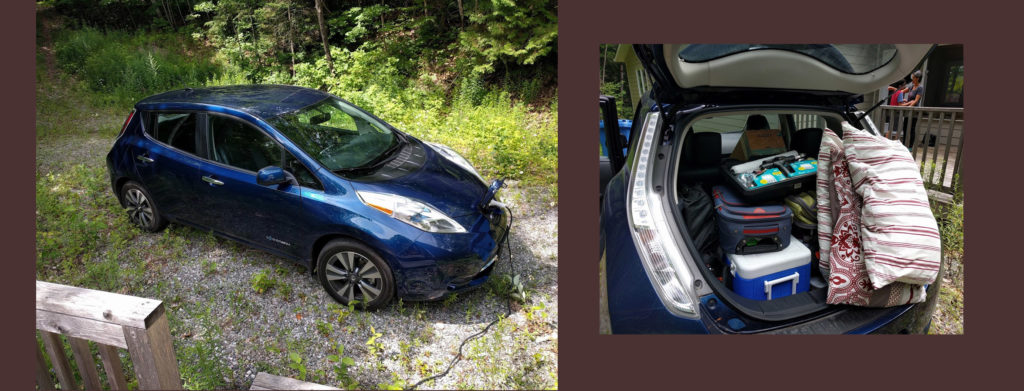
The Stash-inlaws (in Ottawa, Canada) also bought a Leaf after experiencing ours. Their Leaf easily navigates the rough dirt trail to their cottage in Quebec, carrying five people and their gear.
And it's cheap to operate. Three dollars of electricity fills up my battery, which is good for about 110 miles of mixed driving, or closer to 90 when blazing along at 75MPH on the highway. Charging time (and finding charging stations) is rarely a concern, since the car is always waiting at 100% if you just plug it in when you go to bed.
As part of my research on charging efficiency, I bought a (used) Chargepoint 240 volt charger and installed it on my house. This made home charging really fast, but the unit doesn't get much use: as a form of treasure hunt I still find myself using the many free public stations here in Longmont, to the extent that over 50% of my fuel for the year was free.
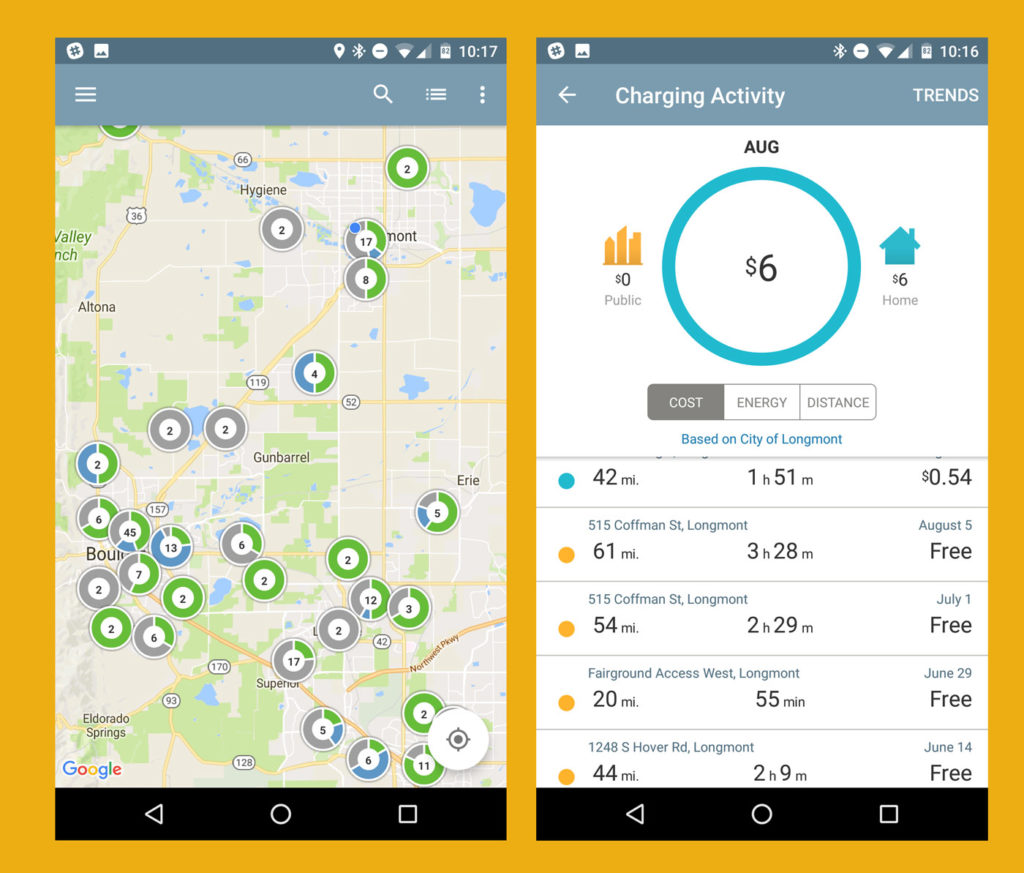
Charging map for Longmont+Boulder and some of my recent charging activity (mostly free!). Ignore the charge times - in many cases the car reached 100% and just sat there until I picked it up. You get about 25 miles of charge per hour on public "level 2" stations, and peak rate of almost 200MPH on a Level 3.
Since the first member of my local friends bought a Leaf, the trend has spread through the community and there are now at least a dozen of the things in the area immediately around me. A friend calls the neighborhood 'Leafmont, Colorado'. The inlaws back in Canada also bought one. People are using these cars for long daily commutes to Boulder and beyond, shuttling kids, shopping, and all the other stuff people shouldn't really be doing with cars, but are going to regardless of what I say. They love their electric cars. The reviews are almost universally raving.
And all of this is aside from the biggest benefit, which is the hidden one that you're not burning fossil fuels. The US power grid is down to 30% coal and getting cleaner every day, and you can personally improve that number simply by buying renewable power from your local provider as I do here in Longmont.
So, if you do need to use a car on a regular basis for around-town use, there's really no reason not to use an electric one.
What about Winter Driving?
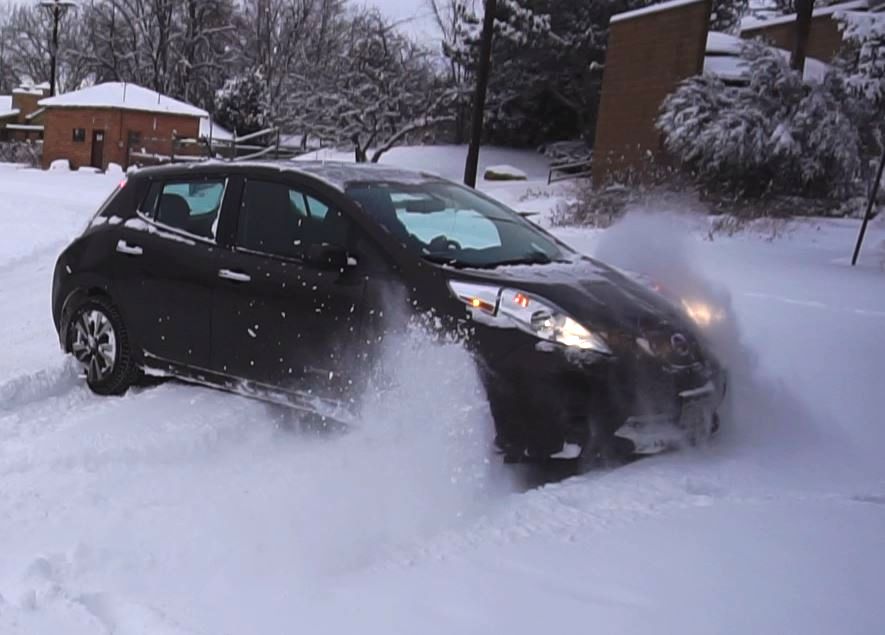
Luckily, if you turn off Traction Control, you can still do great Reverse Donuts in snowy parking lots.
The Leaf and other electric cars have big advantages over gas burners in this area as well.
- The electronic traction and stability control systems work much better with an electric motor, because it can be controlled more precisely. In practice this means that while a normal car would dig itself into a rut, the Leaf applies just enough power to get through the snowbank. Or it stops the wheel, giving you a chance to reverse and give it another go.
- There's no cold-cranking worries or waiting for a cold engine to warm up. You press the button, the car is on, and cabin heat is instantaneous.
- The heated seats and steering wheel make the experience even more luxurious (and reduce the need for cabin heat).
- Remote heating with an in-dash timer or from an app on your phone means your car can be heated and defrosted (or cooled in summer) before you even reach it in your driveway. Without even consuming battery power, if you have the car plugged in.
- Big wheel diameter, low center of gravity and 50/50 weight balance make for better handling and traction.
- Front-wheel drive prevents fishtailing, and is every bit as safe as all-wheel drive. Adding snow tires in winter turns the Leaf into a monster snow crusher.
The Bad Stuff
No story (except perhaps one about bike commuting) could possibly be this universally positive, could it? Does Nissan have Mustache secretly on their payroll? Where's the real meat of this story?
The only bad side of my experience has been finding that Nissan is a Big, Dumb, Old company to work with. To be fair, this is probably true for all car companies except Tesla, but when it comes to new technologies like electric cars, it helps to have someone who is on the ball.
I get the impression that somewhere, deep in the heart of Japan, there are some clever engineers who designed and built this car. Then their work was wrapped up in a thousand layers of bureaucracy and they were never allowed to talk to customers or improve their product again, until the next "product cycle".
For example, although I spent $14,000 of my own money and a year of my time to promote their car for free, even helping MarketWatch adapt and re-run the story for free multiple times to their huge nationwide audience, possibly boosting the car's sales quite noticeably, I couldn't get access to a single Nissan engineer to discuss the details of the car's battery management with me. While my local salesman is a rock star, very few other people in the company even know what a kilowatt-hour is. Perhaps they're still riding the gasoline wave of the Nissan Armada and Titan megatrucks, which provide most of their profits.
Because of this, there are a few obvious brain-dead things about the Leaf:
- There's no battery temperature management. This means that in cold weather (15F), you get about 20% less range, even though you could heat the battery to room temperature with just 0.5 kWh (under 2%) of its energy. Or simply use wall power when it's plugged in. A 20% penalty in cold climates to avoid adding a $100 heater. Why!??!
- The phone app is horrible. I don't mean this in the snooty way that cell phone review sites compare each year's identical batch of high-end-phones, it really is bad. On the positive side, you can run a slightly less crappy aftermarket app called "Leaf Manager" which at least makes it usable.
- Nissan doesn't seem to care about its past electric car customers: The 30 kWh battery from 2016 will not fit into a 2015 Leaf, and I'm out of luck if I want to upgrade my car to any of these juicy 2018-and beyond batteries which have been improving at a rapid pace. You can upgrade to a fresh replacement of your current battery, although it'll cost you $5500.The correct way to handle this (as Tesla does) is to make new batteries backwards-compatible whenever possible, and allow old cars to be upgraded with minimal mark-up on the battery. After all, an electric motor can run for over a million miles with zero maintenance. The rest of the car is rock-solid as well. Why not provide a path for these cars to have a healthy 30-year lifespan, getting a longer range every 10 years or so as the batteries need replacement? There's still a chance for the company (or the aftermarket) to correct this problem, so I remain hopeful.
- Some readers have expressed concern about the Leaf's "driver side small overlap front crash" rating (it earns a low rating, while all other safety categories are good). I think it's a statistically insignificant complaint, but Teslas are surely even safer. Plus, the reader correctly pointed out that if I'm going to nitpick about the phone app, I should also mention crash testing.
The shortcomings of Nissan stir up some real anger in me. But it's probably because I like the basic car so much. Nissan's electric car program could capture so many more loving customers, if it were just managed by a charismatic and highly technical leader, rather than a ridiculous pyramid of corporate paper pushers.
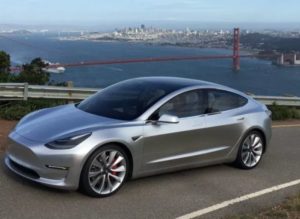 If you want a passionate, perfect car and you have unlimited money, there's only one choice: A Tesla. The Model S right now for $80,000, or a Model 3 next year for $40k.
If you want a passionate, perfect car and you have unlimited money, there's only one choice: A Tesla. The Model S right now for $80,000, or a Model 3 next year for $40k.
If you want a really good electric car and don't want to wait for a Tesla model 3, the Chevrolet Bolt is a great car with 240 miles of range, much better software, similar rockstar acceleration and "only" $30k after the $7500 federal tax credit since they haven't run out yet.

Chevrolet Bolt
But although it's a better car than the Leaf, I would have a hard time justifying the extra $10,000 cost of the Bolt. The extra range makes no difference for the typical urban and suburban driving cycle. But it's still no good for cross-country road trips because it will still only fast-charge at 50 kW, the same as a Leaf. If you can even find a fast charger out in rural Wyoming. Compare this to Teslas, which charge at 120 kW with chargers along every highway in many of the world's rich countries.
But for non-millionaires, buying a $30,000 car is about as clever as shooting yourself in the wallet. It's not even a remotely rational option, so flush it from your mind. The Nissan Leaf (and other electric mid-priced cars) are the best affordable option for driving, if you are still stuck in a life that requires a car.
So the Mustache family will probably be keeping the Leaf and continuing to work it hard for the coming year or more. I may add a trailer hitch and some other minor upgrades, but for the vast majority of our possible uses for a car, it's a pretty amazing deal.
* About $530, just for registration, just for one year. They charge you extra for the first 3 years when you get a new car around here, compared to about $50 per year for my old van and previous car, a Scion xA. The hidden costs of Luxury Racing Wheelchair ownership are really big, and often overlooked.
** Although certain curmudgeons in this website's forum don't believe me, it's hard to explain the shift that happens in your life when you truly don't need a car to get around. Before the change, a car is a reassuring necessity - just as important to your life as as a bed and clothing. After the change, you see a car for what it really is: an exorbitantly complex rolling living room. Thousands of pounds of glass and metal, with robotic arms to wipe the windows and a thousand components just for the portion to control the air temperature around you. A car is no more a reasonable form of personal transportation than a cruise ship is a vessel for weekend fishing expeditions on the lake. But, since Mr. Money Mustache represents only a very mild form of frugality, he still gets to use and review these fancy toys!
